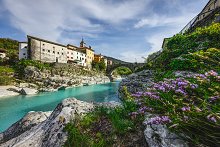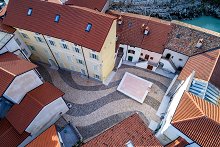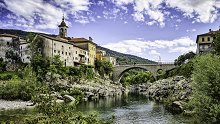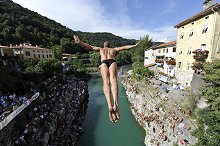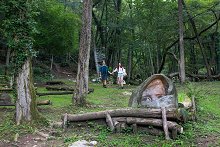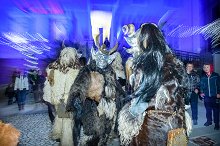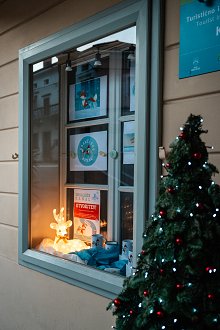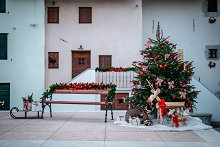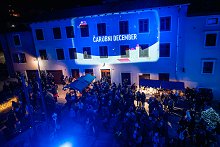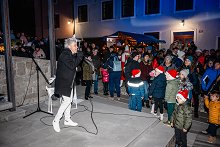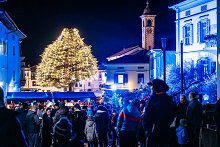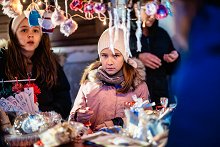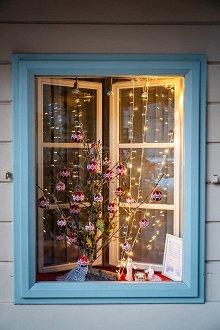Kabrca
A kabrca is a triangular-shaped pipe made of clay. It was used for "Dehnar`s" accommodations at work, contemplating and rituals. Dehnar was the leader of the "Staroverci" which literally means old believers. Slovenia is one of the few countries where organised paganism survived until the 20th century in the western part of Slovenia and Bohinj. Folk tradition, which was collected by the Publicist Pavel Medvešček on the Trnovsko-Banjška plateau, in Posočje and elsewhere, shows that there were pagan communities with their priests that were still active up to the First World War. Since Christianity prosecuted them it was strictly secret, so they lived seemingly as Christians.
 The Kabrca presents a replica of the pipe designed according to the sketch and an exact outline of the original pipe. The original pipe was brought to Medvešček by Jerin who refused to say who its true owner was. Medvešček kept the original pipe only for such a time that he was able to draw it in its natural size and exact dimensions (scale 1:1). In accordance to his sketch, the pipe was later made by a Ceramist, Ms Alenka Gololičič, from Gorenje Log by Most na Soči, an active member of the Kanal’s Club of Ceramists. Even though, Jerin had told and confided a lot about the tradition of the ancient believers to Medvešček, the latter never found out his real name, let alone his date of birth and the place of residence. Due to Jerin’s valuable information and strong connection of all the Old Believers, Medvešček never really wanted to find out who Jerin really was.
The Kabrca presents a replica of the pipe designed according to the sketch and an exact outline of the original pipe. The original pipe was brought to Medvešček by Jerin who refused to say who its true owner was. Medvešček kept the original pipe only for such a time that he was able to draw it in its natural size and exact dimensions (scale 1:1). In accordance to his sketch, the pipe was later made by a Ceramist, Ms Alenka Gololičič, from Gorenje Log by Most na Soči, an active member of the Kanal’s Club of Ceramists. Even though, Jerin had told and confided a lot about the tradition of the ancient believers to Medvešček, the latter never found out his real name, let alone his date of birth and the place of residence. Due to Jerin’s valuable information and strong connection of all the Old Believers, Medvešček never really wanted to find out who Jerin really was.
Object: Pipe (replica)
Local name: KABRCA
Place of find: Čiginj
Year of find: 1968
Donor: Jerin
Material: Clay
Dimensions: 11 cm in length, 11 cm in height (triangular shape)
Owner: Pavel Medvešček
Maker: Alenka Gololičič - Galnatural
Foto: Radivoj Zavadlav, fototeka Goriškega muzeja (https://goriskimuzej.si)
SOLAR KABRCA
The Solar Kabrca is a triangular-shaped pipe made of clay that has six holes in its front section. It was used for the Spring Festival at the Sončna skala and Kresija when making a bonfire. Ivan Gerbec narrated that the Solar Kabrca was already at his house during his grandfather’s lifetime, when he whistled on it as a young man. He used to whistle on it at the Shrovetides and various balls with other musicians. As he also told he whistled on it at least once by the bonfire at Kresija. Before the start of the First World War, his grandfather hid the pipe in the pavement of the pigsty and, in this way, kept it in his family. Therefore, all the members of the family could whistle on it up until the Second World War when it disappeared from the house without anyone knowing when and who took it. Ivan’s grandfather used to say that the pipe had a partition in the middle, due to which the left half whistled differently than the right half. The pipe was made in a way that they first made the bottom half with a rim. Then they designed a partition, which did not go all the way to the end. After that they filled altogether with wax. When the wax set hard, the upper part of Kabrca was placed over it. It is said that the pipes were made at Laštar’s on Ušnik. As Pavel Medvešček never saw the pipe in person, he drew it according to the testimony of Ivan Gerbec. The latter told that the pipe had six holes in the front section – three on the left and three on the right side – but he did not recall their exact positions nor their sizes. What he did remember precisely was that one of the holes was located on the bottom and one in the back side, right under the mouthpiece, but he did not recollect if the holes were also positioned at the side. Kabrca was painted in a sunny-yellow colour that was extracted from barberry. Janez Strgar further explained that they used to play on Kabrca when the sun first shone its rays on the Sončna skala in spring. At that time, all Old Believers from the surrounding villages gathered together at Kresija and celebrated. The person, who played at such celebrations, was determined every year individually by Dehnar. Namely, Dehnar tested the young men and then chose only the best due to which the number of musicians was never the same.
According to the sketch of Pavel Medvešček, the solar kabrca was later designed by the Ceramists, Ms Alenka Gololičič, from Gornji Log near Most na Soči, who is an active member of the Kanal’s Club of Ceramists. Alenka Gololičič and Pavel Medvešček cooperated tightly during the making period of the solar kabrca. In the end they consulted with Dr. Drago Kunej from the Institute of Ethnomusicology SAZU who explained for which occasions they used the pipes with low tones. The pipe was then tested by Luka Ipavec and Boštjan Gombaš, both a well-known Slovenian instrumentalists, who when playing discovered how to achieve a greater clarity and volume. Due to that Pavel Medvešček recognises Alenka Gololičič as the only authentic maker of the pipe. The pipe can also be made as a souvenir.
Place of find: Dolina
Year of find: 1971
Narrator: Ivan Gerbec, born in 1932 at Tomajžč, Dolina, Doblar 43
Material: Clay
Dimensions: 20.5 cm in length, 21.5 cm in height and 5 cm thick (triangular shaped)
Owner: Pavel Medvešček
Maker: Alenka Gololičič
Photo: Radivoj Zavadlav, fototeka Goriškega muzeja (https://goriskimuzej.si)
The photographs and text are from the Catalog " Staroverstvo in staroverci, etnološka zbirka Pavla Medveščka " published at the exhibition of the same name. The research, exhibition and catalog were organized and set up in the Goriški Muzej (2013 - 2018) with the financial support of the Municipality of Kanal ob Soči
Source: Staroverstvo in staroverci, Pavel Medvešček in mag. Darja Skrt (author of the exhibition)
